人教版英语八年级下册unit1教案
人教新目标八年级英语下册教案Unit1Whatsthemat教案

Unit1 What’s the matter?复习课教学设计一、设计背景初中英语升学考试所涉及的知识面广,因而复习时需要扎扎实实打好基础,对课本的复习可以说是以“地毯式”搜捕的方式进行的。
教师要在有限的时间内完成如此大容量的复习任务,就必须要想方设法提高复习效率,让学生的复习取得事半功倍的效果。
我在复习中采用“知识递进式”复习法,用话题带动词句的使用,注重知识的综合运用。
二、设计理念本课是以“problems and advice”为话题的复习课,课堂上把主动权交给学生,以听说训练为主线,通过看、听、说、写等一系列教学活动,让学生运用所学知识来完成单词拼写、即时翻译短语、小组合作翻译句子,定时背诵语篇。
使学生获得最基本的英语听、说、读、写能力,并在教学中充分激发学生强烈的学习愿望。
在注重学生知识能力发展的同时,注重提高学生的人格修养,学会关心别人,帮助别人,达到培养学生互助的德育教育的目的。
三、教学目标设计用具体、明确、可操作的行为语言,描述本课的知识、技能、能力、方法、情感、态度、价值观等方面的教学目标。
Objectives: By the end of the session, most students will be better able to acquire the required information. This will be achieved by: 1.Knowledge Objectives:1)Be able to master the pronunciation, meaning and spellingof the names of diseases: fever, sore throat, sore back; stomachache, headache, toothache, cold, cough; 2) Be able tolearn the e某pressions of giving advice: lie down and rest, drink hot tea with honey, see a dentist, take this medicine;3) Be able to talk about health problems by using “What’s the matter? I have a?” and give advice by using “Youshould?You shouldn’t?” 2. Ability Objectives:1) Be able to talk about one’s health problems and give advice fluently; 2) Be able to role play doctor and patient; 3. Moral Objectives:1) Improve the cooperative spirit through pair work and role playing 2) Care more about yourself and your family members’ health. 四、教学重点难点设计由于本节课的话题是谈论健康,根据教学大纲的要求,学生需掌握有关疾病的单词,并能针对疾病提出合理的建议。
人教版八年级英语下册第一单元教案
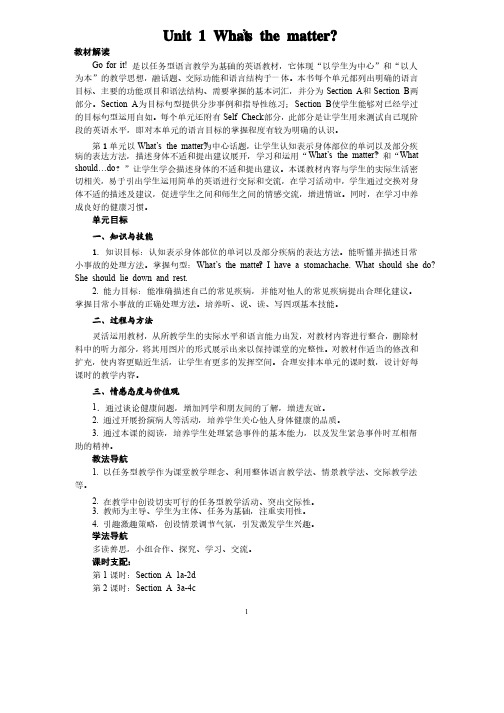
1 Unit 1 What’s the matter? 教材解读Go Go for for for it! it! 是以任务型语言教学为基础的英语教材,它体现“以学生为中心”和“以人为本”的教学思想,融话题、交际功能和语言结构于一体。
交际功能和语言结构于一体。
本书每个单元都列出明确的语言本书每个单元都列出明确的语言目标、主要的功能项目和语法结构、需要掌握的基本词汇,并分为Section A 和Section B 两部分。
Section A 为目标句型提供分步事例和指导性练习;Section B 使学生能够对已经学过的目标句型运用自如。
每个单元还附有Self Check 部分,此部分是让学生用来测试自己现阶段的英语水平,即对本单元的语言目标的掌握程度有较为明确的认识。
第1单元以What’s What’s the matter? the matter?为中心话题,为中心话题,让学生认知表示身体部位的单词以及部分疾病的表达方法,描述身体不适和提出建议展开,学习和运用“What’s What’s the matter? the matter?”和“”和“What should…do ”让学生学会描述身体的不适和提出建议。
?”让学生学会描述身体的不适和提出建议。
本课教材内容与学生的实际生活密本课教材内容与学生的实际生活密切相关,易于引出学生运用简单的英语进行交际和交流,易于引出学生运用简单的英语进行交际和交流,在学习活动中,在学习活动中,学生通过交换对身体不适的描述及建议,促进学生之间和师生之间的情感交流,体不适的描述及建议,促进学生之间和师生之间的情感交流,增进情谊。
同时,在学习中养增进情谊。
同时,在学习中养成良好的健康习惯。
单元目标一、知识与技能1. 1. 知识目标:认知表示身体部位的单词以及部分疾病的表达方法。
能听懂并描述日常知识目标:认知表示身体部位的单词以及部分疾病的表达方法。
能听懂并描述日常小事故的处理方法。
人教版八年级下册英语教案unit1
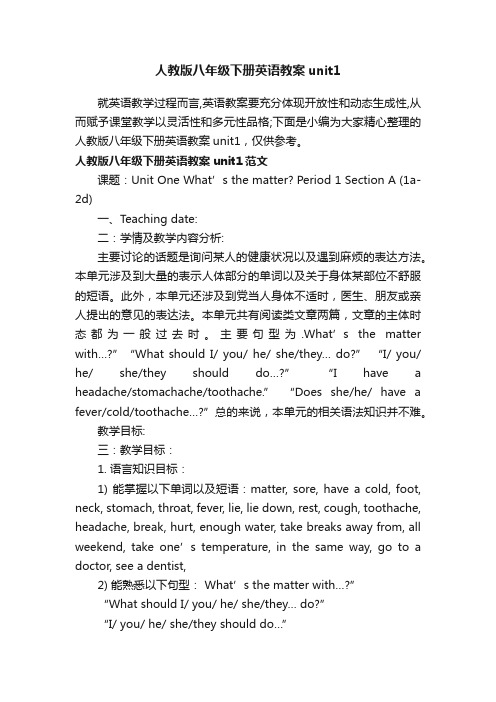
人教版八年级下册英语教案unit1就英语教学过程而言,英语教案要充分体现开放性和动态生成性,从而赋予课堂教学以灵活性和多元性品格;下面是小编为大家精心整理的人教版八年级下册英语教案unit1,仅供参考。
人教版八年级下册英语教案unit1范文课题:Unit One What’s the matter? Period 1 Section A (1a-2d)一、Teaching date:二:学情及教学内容分析:主要讨论的话题是询问某人的健康状况以及遇到麻烦的表达方法。
本单元涉及到大量的表示人体部分的单词以及关于身体某部位不舒服的短语。
此外,本单元还涉及到党当人身体不适时,医生、朋友或亲人提出的意见的表达法。
本单元共有阅读类文章两篇,文章的主体时态都为一般过去时。
主要句型为.What’s the matter with…?”“What should I/ you/ he/ she/they… do?” “I/ you/ he/ she/they should do…?” “I have a headache/stomachache/toothache.” “Does she/he/ have a fever/cold/toothache…?”总的来说,本单元的相关语法知识并不难。
教学目标:三:教学目标:1. 语言知识目标:1) 能掌握以下单词以及短语:matter, sore, have a cold, foot, neck, stomach, throat, fever, lie, lie down, rest, cough, toothache, headache, break, hurt, enough water, take breaks away from, all weekend, take one’s temperature, in the same way, go to a doctor, see a dentist,2) 能熟悉以下句型:What’s the matter with…?”“What should I/ you/ he/ she/they… do?”“I/ you/ he/ she/they should do…”2. 情感态度价值观目标:教会学生关心他人,培养同学间团结、友善的精神。
八年级英语下册教案人教版核心素养unit 1英文版

八年级英语下册教案人教版核心素养unit 1英文版全文共3篇示例,供读者参考篇1Unit 1: My future jobPart 1: Teaching Objectives1. Knowledge and skills goals:- Students can understand and use vocabulary related to future jobs.- Students can talk about their dreams and aspirations.- Students can describe their future job and career aspirations.2. Process goals:- Students can participate in group discussions and share their ideas.- Students can practice listening, speaking, reading and writing skills.3. Emotion and values goals:- Students can develop a positive attitude towards planning for their future.- Students can appreciate the importance of setting goals and working towards achieving them.Part 2: Teaching Content1. Vocabulary: job titles (teacher, doctor, engineer, etc.), job responsibilities (teaching, healing, designing, etc.), job requirements (skills, education, experience, etc.).2. Grammar: Future tense (will/won't + base form of the verb).3. Speaking and Listening: discussing future goals and aspirations, describing future job aspirations.4. Reading and Writing: reading and writing about future job aspirations.Part 3: Teaching Procedures1. Warm-up: (10 minutes)- Show pictures of different job titles and ask students to guess the job titles.- Play a guessing game where students describe a job without using the job title and others have to guess the job.- Discuss the importance of setting goals and working towards achieving them.2. Presentation: (20 minutes)- Introduce vocabulary related to future jobs using flashcards or pictures.- Present and practice the future tense with examples.- Show a video or audio clip of people talking about their future career aspirations.3. Practice: (30 minutes)- Divide students into pairs or small groups to discuss their dreams and future job aspirations.- Have students write a short paragraph describing their future job aspirations.- Conduct a role play activity where students act out a job interview scenario.4. Production: (20 minutes)- Ask students to present their future job descriptions to the class.- Have students write a short essay about their dream job, including job title, responsibilities, requirements, and reasons for choosing that job.5. Review: (10 minutes)- Review vocabulary and grammar covered in the lesson.- Summarize key points and discuss the importance of setting goals for the future.Part 4: Assessment- Assessment can be done through written assignments, oral presentations, and class participation.- Encourage students to reflect on their learning and set goals for improving their English skills in the future.篇2Unit 1: Our worldLesson 1: We need to protect our worldObjectives:1. Students will be able to understand the importance of protecting our environment.2. Students will be able to discuss different ways to protect our world.3. Students will be able to use target vocabulary related to the environment.Warm-up: To start the lesson, the teacher can show pictures of environmental issues such as pollution, deforestation, and climate change. Students can discuss in pairs or small groups what they see in the pictures and why it is important to protect our world.Presentation: The teacher can introduce key vocabulary words related to the environment such as pollution, recycling, conservation, and sustainable. Students can repeat after the teacher to practice pronunciation.Practice: Students can work in pairs to discuss different ways to protect our environment. They can also brainstorm ideas on how they can make a difference in their daily lives to help the environment.Production: In groups, students can create a poster or a presentation about a specific environmental issue and how theycan make a positive impact in solving it. They can present their work to the class and engage in a discussion about each group's topic.Homework: Students can write a short paragraph about what they can do to protect our world. They can also research and find information about a specific environmental issue and write a summary of their findings.Assessment: The teacher can assess students based on their participation in class discussions, their creativity and teamwork during the group project, and the quality of their homework assignment.Overall, this lesson aims to raise awareness about the importance of protecting our environment and empower students to take action to make a difference in the world. By fostering a sense of responsibility and empathy towards the planet, students will be better equipped to contribute to a more sustainable and eco-friendly future.篇3Unit 1 Get ready for the futureTeaching Goals:1. Enable students to understand and use the target language in real-life situations2. Develop students' listening, speaking, reading, and writing skills3. Encourage students to think about their future plans and goalsTeaching Procedures:Part 1: Warm-up (10 minutes)- Start the lesson by asking students about their future plans and goals. This can be done in a whole-class discussion or in small groups.- Have students share their aspirations, such as what they want to be when they grow up or where they want to visit in the future.- Encourage students to think about why these goals are important to them and how they plan to achieve them.Part 2: Listening and Speaking (20 minutes)- Play a video or audio clip of people talking about their future plans and goals. Ask students to listen carefully and take notes.- After playing the clip, have students work in pairs or small groups to discuss what they heard and share their notes.- Encourage students to ask each other questions about their future plans and offer advice or support.Part 3: Reading (20 minutes)- Distribute a reading passage about different career options and their requirements. Have students read the passage silently and underline any unfamiliar vocabulary.- Divide students into pairs and have them discuss the different career options mentioned in the passage. Ask them to talk about the skills and qualifications needed for each career.- The teacher can then lead a whole-class discussion on the importance of education and training in achieving future goals.Part 4: Writing (20 minutes)- Ask students to write a short paragraph about their future plans and goals. They can include information about their desired career, education, hobbies, and aspirations.- Encourage students to use the target language learned in class and to be as descriptive as possible.- Once students have finished writing, have them share their paragraphs with a partner or with the whole class.Part 5: Assessment and Extension (10 minutes)- To assess students' understanding of the lesson material, give them a short quiz on the target language and key concepts covered in class.- For extension activities, ask students to research a specific career or field of interest and present their findings to the class.- Provide feedback on students' work and encourage them to continue thinking about their future plans and how they can achieve success.Homework:Assign students to write a reflection on their future goals and the steps they will take to achieve them. Encourage them to be specific and realistic in their planning.Overall, this lesson aims to inspire students to think about their future with optimism and determination. By developing their language skills and critical thinking abilities, students will bebetter prepared to face the challenges and opportunities that lie ahead.。
人教版八年级英语下册《Unit 1 Unit 1 What’s the matter?》教案.doc
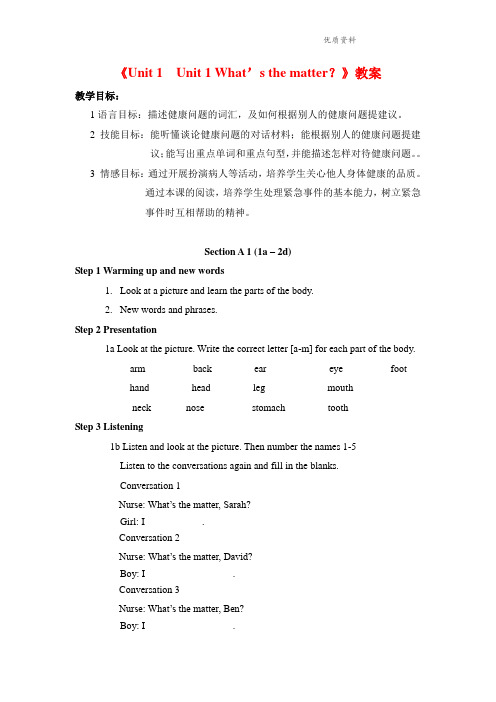
《Unit 1 Unit 1 What’s the matter?》教案教学目标:1语言目标:描述健康问题的词汇,及如何根据别人的健康问题提建议。
2 技能目标:能听懂谈论健康问题的对话材料;能根据别人的健康问题提建议;能写出重点单词和重点句型,并能描述怎样对待健康问题。
3 情感目标:通过开展扮演病人等活动,培养学生关心他人身体健康的品质。
通过本课的阅读,培养学生处理紧急事件的基本能力,树立紧急事件时互相帮助的精神。
Section A 1 (1a – 2d)Step 1 Warming up and new words1.Look at a picture and learn the parts of the body.2.New words and phrases.Step 2 Presentation1a Look at the picture. Write the correct letter [a-m] for each part of the body.___arm ___ back ___ ear ___ eye ___ foot___hand ___ head ___ leg ___ mouth___ neck ___nose ___ stomach ___ toothStep 3 Listening1b Listen and look at the picture. Then number the names 1-5Listen to the conversations again and fill in the blanks.Conversation 1Nurse: What’s the matter, Sarah?Girl: I ___________.Conversation 2Nurse: What’s the matter, David?Boy: I _________________.Conversation 3Nurse: What’s the matter, Ben?Boy: I _________________.Conversation 4Nurse: What’s the matter, Nancy?Girl: I _________________.Conversation 5Betty: What’s the matter, Judy?Ann: She __________________.Step 4 Speaking1c Look at the pictures. What are the students’ problems? Make conversati ons.ExamplesA: What’s the matter with Judy?B: She talked too much yesterday and didn’t drink enough water.She has a very sore throat now.A: What’s the matter with Sarah?B: She didn’t take care of herself on the weekend. She was p laying withher friends at the park yesterday. Then it got windy, but she didn’t puton her jacket. Now she has a cold.Step 5 Guessing gamesGuess what has happened to the students by using the important sentenc es. Step 6 Listening2a Listen and number the pictures [1-5] in the order you hear them.2b Listen again. Match the problems with the advice.Step 7 Speaking2c Make conversations using the information in 2a and 2bA: What’s the matter?B: My head feels very hot.A: Maybe you have a fever.B: What should I do?A: You should take your temperature.Step 8 Role–playImagine you are the school doctor. A few students have health problems.Role-play a conversation between the doctor and the students.2d Role –play the conversationStep 9 Language points and summary1. What’s the matter?这是人们特别是医生和护士询问病人病情时最常用的问句, 意思是“怎么了?”其后通常与介词with连用。
人教版八年级英语下册Unit 1(1)教案

新人教版八年级英语下册Unit 1(1)教案Teaching goals:1. Words&phrases: robot, paper, less, fewer, simple, unpleasant, factory, seem, etc .2. will 构成的一般将来时态的陈述句、否定句、疑问句及回答.3. There be 句型的一般将来时.4. more , less , fewer 的用法.5. 学习一般将来时态的相关知识,学会对未来进行预测.6. 对five years ago ,today ,in five years 简洁回顾与展望的方式,贴近实际符合学生心理,激发学习兴趣.7. 通过时间对比复习一般过去时态、一般现在时态,巩固一般将来时.Important and difficult points :1. will构成一般将来时态的句式。
2. There be 句型的一般将来时态。
3. more , fewer , less 的用法。
4. How to make predictions .Period 1Teaching procedures:Step 1 Leading in1. Greetings: Welcome to sc hool .What’s the date today ? Who’s on duty today ?Do you enjoy your winter holiday ?Do you finish your homework ?Do you want to live on the moon ?Can you guess what will happen in ten years ?Collect the Ss’ answers and say something about their predictions .Step 2 Pre-taskPage 2 ,1a .1. Look at the picture :How will the world be different in the future ,100 years from now ?We’re going to talk about sth in 100 years .2. Read each predictions to the class .Explain the new vocabulary .3. Read the instructions .Make sure Ss know what they should do .4. Do it by themselves .5. Talk about the answers with the class .Explain :一般将来时态构成: will / be going to +动词原形Step 3 While-taskPage 2 ,1b .1. Practise reading the six predictions .2. Read the instructions to Ss .Circle the things you hear on the recording .3. Play the tape twice .4. Play the tape a third time .At the same time ,check the answers .Page 2 , 1c .1. Pay attention to the dialogues .2. Read the dialogues fluently .3. Pairwork .Work in pairs to make predictions according to the sample .4. Ask several pairs to share their conversations to the class .Page 3 , 2a & 2b .1. Read the predictions .2. Read the instructions and point out the sample answer .3. Play the tape twice .Ss circle the word they hear in each sentences: more , less , fewer .4. Check the answers .学生探究: less , fewer 的区别。
初中英语人教版八年级下册Unit1教案
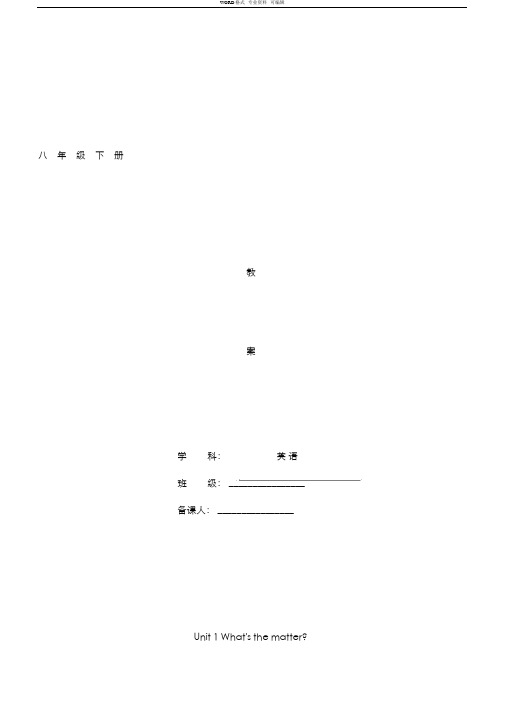
八年级下册教案学科:英语班级: ________________ 备课人: ________________Unit 1 What's the matter?Period 1 Section A 1a-1cTeaching aims:1)Ss can use the following words: head , ear, eye, mouth, nose, throat , neck, back, hand, arm, leg, tooth-teeth, foot-feet , matter, have a cold, stomachache, , backache, headache, toothache2)Ss can use the following sentence patterns:What's the matter? I have a stomach./I have a sore back./I have a cold.He/She has a sore throat.Ability aims: Learn how to talk about health problemsImportant & difficult points:Learn how to talk about health, use have to talk about health problemsTeaching aids: recorder, computerTeaching proceduresStep 1 Warming-upSing an English song: If you're happy and you know it, clap your hands.Step 2 Word study1.Greeting2.Teach the parts of the body one by one by touching it. While teaching one, let them touch or show it.3.Present a picture of a baby and Yao Ming. let the Ss say the parts of the body.4.Work on Section A 1a5.Play a game: Touch the parts of your body1)Let the whole class touch the parts of their body when teacher say: Touch your ⋯2)Ask eight Ss to come to the front and do as the teacher tells them: Touch your ⋯ if one does wrong, let him or her go back, the last one who in the front is the winner.Step 3 Presentation and practicePresent other pictures, talk about health problems of the persons in the pictures.What's the matter? He/ She has a headache/ toothache /a sore back/ a sore throat/a cold and a cough.3.Let the Ss practice in pairs4.Make a model dialogue with two Ss.T:Oh, that's too bad. I'm sorry to hearthat. Let the Ss practice in pairs.Step 4 ChantHead, head, I have a headache. I have a headache,Stomach, stomach, I have a stomachache. I have a stomachache,Ear, ear, I have an earache. I have an earache, Tooth, tooth, I have a toothache. I have a toothache. Back, back, I have a sore back. I have a sore back, Throat, throat, I have a sore throat. I have a sore throat.Oh, dear! Do more exercise, please and keep healthy!Step 5 listen and sayWork on Section A 1b.Listen and number the names 1-5.Talk about the health problems of the persons in the picture.Step6 SummaryStep 7 Quiz一.用方框中所给单词的适当形式填空foot,sore,cough,matter,hurt1. Nancy ________ all night,so she looked tired this morning.2. I saw many reporters walking around your house.What's the ?3. You can touch the cat's back,but don't touch its ________. 4. The boy fell off the tree and ________ his left foot.5. Miss Yang has a ________ throat,so she can't talk more.二. 单项选择( )1.I'm afraid you have to get ________ X- ray,young man.A .a B.an C.the D./( )2.I have to see the doctor because my stomach ________ badly.A .hurt B.hurts C. breaks D.broke( )3.—Tom's head feels very hot now.— Maybe he ________.Please take him to go to a doctor.( ( A .has a sore throat B.has a toothache C.has a fever D. has a stomachache)4.Mike often goes to school without ________ breakfast.A .have B.has C.to have D.having)5.—________?— I have a bad cold.A .What are you doing B.How are you C.What's it D.What's the matterStep 8 Blackboard designUnit 1 What's the matterThe First PeriodTooth—teeth(pl) foot---feet(pl)Toothache stomachache Eyes nosemouthears Period 2 Section A 2a-2dTeaching AimsKnowledge aims:1.Review the names of each part of the body and thenames of the illness.2.Continue to learn the names of the illness: toothache, fever and headache.Ability aims:1.Learn some advice to keep healthy.2.Learn to give others some advice according to their matters. Emotion aims:1. Learn to live in a healthy way.2. Learn to take care of others and themselves.二. Teaching Key Points & Difficult Points:1.How to teach the Ss to learn the names of the illness: toothache, fever and headache.2.How to give others some advice according to their matters.3.Learn how to take care of themselves and others.Step1. Warming upEnjoy and sing an English song: Head and shoulders knees and toesHead and shoulder knees and toesKnees and toes, knees and toes,Head and shoulder knees and toesEyes, ears, mouth, nose(Repeat 4 times)Step2. Greeting and revision1.Greet the whole class as usual.T:What's the date today?/ What day is it today?/ How's the weather?/ How was your weekend?/What do you usually do on weekends?/ Do you like exercising?/ How often do you exercise?/ That's great! To do exercise can keep us healthy, but if we don't pay attention to our health, there will be something wrong with our body. Now , look at these people.2.RevisionT:(Show pictures) How is he/she? ( He / She is not fine.) www-2-1-cnjy-com What's the matter?He /She has a cold (flu) / stomachache/ sore back.Step3. PresentationGuessing gameT shows some part of the pictures to the Ss and let them guess .T:What's the matter with him/her?S:Does he/she have a⋯ ?T:Yes, he/she has a sore throat (Teach the new word) Can you give him/ her some advice? What should he /she do? (Teach the new word)21世纪教育网版权所有S:He /She should drink hot tea with honey/ shouldn't speak more/ go to see a doctor⋯(Ss can give different advice as they like)T:What's the matter with him/her?S:Does he/she have a⋯ ?T:Yes, he / she has a / an toothache /fever / headache/ earache⋯(Teach the new words) What should he /she do?S:He /She should go to see a dentist / shouldn't eat ice cream/shouldn't drink cold water /lie down and rest / shouldn't play basketball/ should drink a lot of water./should see a doctor⋯Step4. PracticeDo 2a. Listen. Match the problems with the advice.Play the tape for the Ss and let them do it by themselves. Then check the answer.Do 2b. Listen again . Fill in the blanks.Play the tape for the Ss. At the first time, let them do it by themselves. Then play it again and checkthe answer.Do 2c. Pair work.. Role play the conversations in 2b. Let the Ss read the conversations in 2c first.Work in pairs, make a new conversation according to 2b. Show more pictures and let the Ss make more conversations.ProblemsShould Shouldn'tSee a doctor/TakeEat ice cream.A coldsome pills/Drink a Drink cold water.A feverlot of water Go swimming.A headache Lie down and rest/ Watch TV late. A stomachacheGo to bed early. Speak loudly.A sore throat Drink some hot tea Eat some hot food. A sore backwith honey Eat sweet food.A toothacheDo some exercisesSee a dentistStep5. Work on 2dWork in groups and discuss how to keep ourselves healthy. ShouldShouldn'treport: To keep healthy, we should ⋯ we shouldn't ⋯Step6 SummaryStep7 Quiz一、用括号内所给单词的适当形式填空。
新人教版八年级英语下册Unit1(1)教案

新人教版八年级英语下册Unit1(1)教案In this lesson。
we will be learning about health problems and how to give advice。
Our language goals are to learn vocabulary related to health problems and how to give advice based on someone's health issues。
Our skill goals are to be able to understand dialogues about health problems。
give advice based on someone's health issues。
and write key words and sentences related to health problems。
Our values goal is to cultivate students' empathy towards others' health and to promote a spirit of mutual help during emergencies.We will be focusing on phrases such as "have a stomachache," "have a cold," "lie down," "take one's temperature," "go to a doctor," "get off," "to one's surprise," "agree to do sth," "get into trouble," "fall down," "be used to," "run out (of)," "cut off," "get out of," "be in control of," "keep on (doing sth.)," and "give up." We will also be practicing sentences such as "What's the matter?" and "I have a stomachache。
人教版八年级下册英语Unit1(第一单元)优秀教案

Unit 1 What's the matter?第一课时Section A (1a2d)【教学目标】1.重点单词:matter,back,sore,throat,stomachache,foot,neck,stomach,fever,lie,rest,cough,Xray,toothache,headache2 重点短语:have a sore throat,have a stomachache,have a cold,lie down,take one's temperature,have a fever,go to a doctor3 重点句式:—What's the matter?—She talked too much yesterday and didn't drink enough water.She has a very sore throat now.You should drink some hot tea with honey.It doesn't sound like you have a fever.You need to take breaks away from the computer.I think I sat in the same way for too long without moving.If your head and neck still hurt tomorrow,then go to a doctor.【学习重点】1 重点短语和句型2 询问对方身体状况的句型及答语【学习难点】询问对方身体状况的句型及答语【自主学习】一、预习课本P12新单词并背诵,完成下面的汉译英。
1 问题____________ 2.背部____________3 疼痛的____________ 4.嗓子____________5 胃痛____________ 6.脚____________7 脖子____________ 8.胃____________9 发烧____________ 10.平躺____________11 休息____________ 12.咳嗽____________13 X光____________ 14.牙疼____________15 头疼____________二、认真预习1a2d找出下列短语和句型。
人教版英语八年级下册-Unit 1 Section A (1a—2d)教案
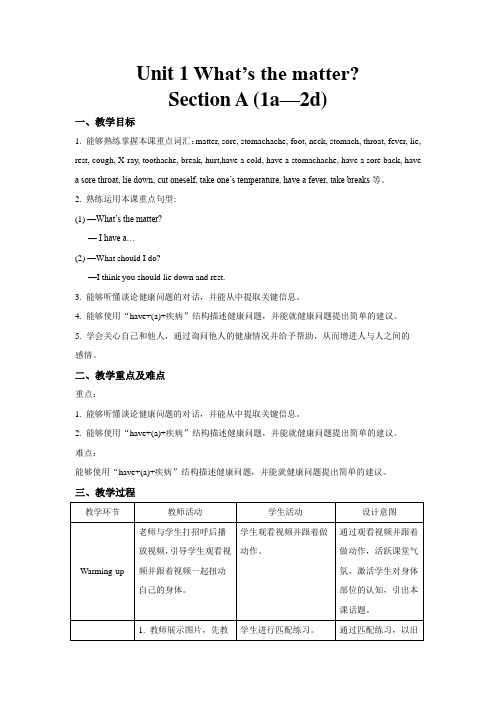
Unit 1 What’s the matter?Section A (1a—2d)一、教学目标1. 能够熟练掌握本课重点词汇:matter, sore, stomachache, foot, neck, stomach, throat, fever, lie, rest, cough, X-ray, toothache, break, hurt,have a cold, have a stomachache, have a sore back, havea sore throat, lie down, cut oneself, take one’s temperature, have a fever, take breaks等。
2. 熟练运用本课重点句型:(1) —What’s the matter?—I have a…(2) —What should I do?—I think you should lie down and rest.3. 能够听懂谈论健康问题的对话,并能从中提取关键信息。
4. 能够使用“have+(a)+疾病”结构描述健康问题,并能就健康问题提出简单的建议。
5. 学会关心自己和他人,通过询问他人的健康情况并给予帮助,从而增进人与人之间的感情。
二、教学重点及难点重点:1. 能够听懂谈论健康问题的对话,并能从中提取关键信息。
2. 能够使用“have+(a)+疾病”结构描述健康问题,并能就健康问题提出简单的建议。
难点:能够使用“have+(a)+疾病”结构描述健康问题,并能就健康问题提出简单的建议。
三、教学过程四、板书设计Unit 1What’s the matter?第1课时Section A (1a—2d)Key words and phrases: matter, sore, stomachache, foot, neck, stomach, throat, fever, lie, rest, cough, X-ray, toothache, break, hurt,have a cold, have a stomachache, have a sore back, have a sore throat, lie down, cut oneself, take one’s temperature, have a fever, take breaksKey sentences:1. —What’s the matter?—I have a…2. —What should I do?—I think you should lie down and rest.。
人教版英语八年级下册Unit 1 SectionA (1a-2d)教案
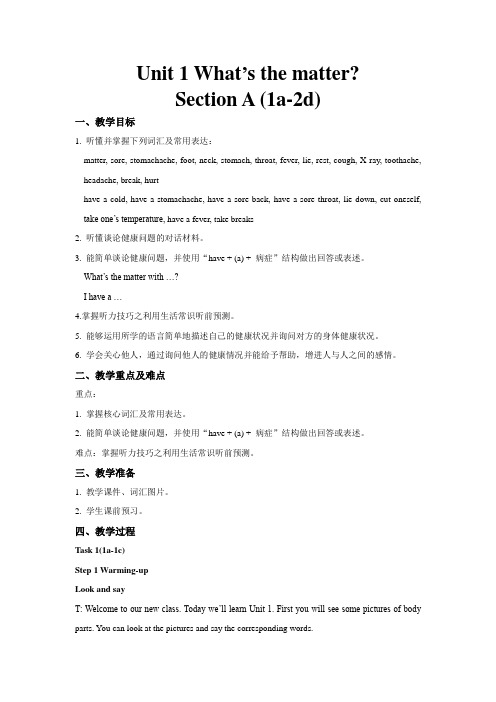
Unit 1 What’s the matter?Section A (1a-2d)一、教学目标1. 听懂并掌握下列词汇及常用表达:matter, sore, stomachache, foot, neck, stomach, throat, fever, lie, rest, cough, X-ray, toothache, headache, break, hurthave a cold, have a stomachache, have a sore back, have a sore throat, lie down, cut oneself, take one’s temperature, have a fever, take breaks2. 听懂谈论健康问题的对话材料。
3. 能简单谈论健康问题,并使用“have + (a) + 病症”结构做出回答或表述。
What’s the matter with …?I have a …4.掌握听力技巧之利用生活常识听前预测。
5. 能够运用所学的语言简单地描述自己的健康状况并询问对方的身体健康状况。
6. 学会关心他人,通过询问他人的健康情况并能给予帮助,增进人与人之间的感情。
二、教学重点及难点重点:1. 掌握核心词汇及常用表达。
2. 能简单谈论健康问题,并使用“have + (a) + 病症”结构做出回答或表述。
难点:掌握听力技巧之利用生活常识听前预测。
三、教学准备1. 教学课件、词汇图片。
2. 学生课前预习。
四、教学过程Task 1(1a-1c)Step 1 Warming-upLook and sayT: Welcome to our new class. Today we’ll learn Unit 1. First you will see some pictures of body parts. You can look at the pictures and say the corresponding words.设计意图:复习已学的单词,为本单元“健康与急救”话题的学习奠定基础。
Unit1What'sthematter人教版英语八年级下册教案

(3)时态运用:一般现在时和现在进行时在本章节的对话和描述中占有重要地位,教师需重点讲解并指导学生如何在询问和描述身体状况时正确运用这两种时态。
二、核心素养目标
《Unit 1 What's the matter》的教学旨在培养学生的英语学科核心素养,具体目标如下:
1.提升学生的语言能力,通过学习本章内容,使学生能够熟练运用英语询问和描述身体状况,表达关心与建议,提高实际生活中的交际能力;
2.增强学生的文化意识,了解和尊重不同文化背景下对待疾病和身体状况的态度及表达方式;
举例:
-当学生询问他人身体状况时,能使用"What's the matter?"这一核心句型;
-当描述自己或他人身体不适时,能运用"I have a stomachache."、"You have a fever."等句型;
-在给出建议时,可以使用"You should take some medicine."等短语。
四、教学流程
(一)导入新课(用时5分钟)
同学们,今天我们将要学习的是《Unit 1 What's the matter》这一章节。在开始之前,我想先问大家一个问题:“你们在日常生活中是否遇到过朋友或家人身体不适的情况?”比如,朋友突然说肚子疼,你会怎么关心和帮助他们呢?这个问题与我们将要学习的内容密切相关。通过这个问题,我希望能够引起大家的兴趣和好奇心,让我们一同探索如何用英语询问和描述身体状况。
新人教版八年级下册初中英语全册教案(教学设计)
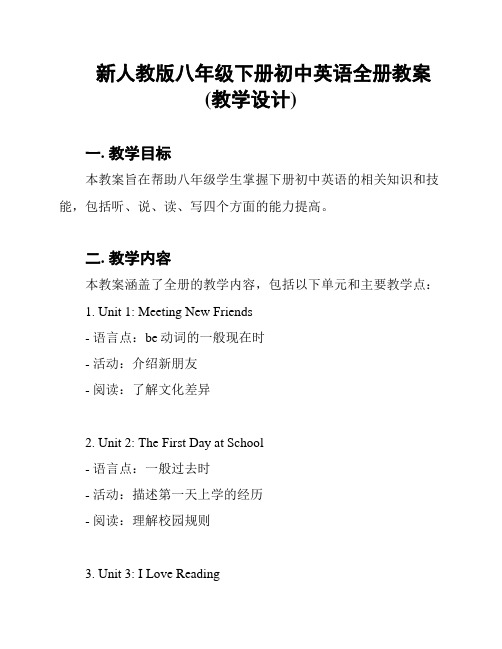
新人教版八年级下册初中英语全册教案(教学设计)一. 教学目标本教案旨在帮助八年级学生掌握下册初中英语的相关知识和技能,包括听、说、读、写四个方面的能力提高。
二. 教学内容本教案涵盖了全册的教学内容,包括以下单元和主要教学点:1. Unit 1: Meeting New Friends- 语言点:be动词的一般现在时- 活动:介绍新朋友- 阅读:了解文化差异2. Unit 2: The First Day at School- 语言点:一般过去时- 活动:描述第一天上学的经历- 阅读:理解校园规则3. Unit 3: I Love Reading- 语言点:情态动词can和must - 活动:介绍喜欢的书籍- 阅读:阅读理解4. Unit 4: My School Life- 语言点:形容词比较级和最高级- 活动:描述学校生活的不同方面- 阅读:了解不同的学校生活5. Unit 5: Our Future Jobs- 语言点:职业相关词汇- 活动:谈论未来的职业- 阅读:了解不同的职业6. Unit 6: Weather and Climate- 语言点:天气相关词汇和短语- 活动:讨论天气和气候- 阅读:了解不同地区的气候7. Unit 7: Enjoy Your Trip- 语言点:旅行相关词汇和短语- 活动:计划和描述旅行- 阅读:阅读旅行指南8. Unit 8: At the Farm- 语言点:动词的现在进行时- 活动:描述在农场的经历- 阅读:了解农场生活三. 教学方法本教案使用多种教学方法,包括但不限于:听力练、口语对话、阅读理解、小组讨论、写作练等。
教师将根据具体情况选择合适的教学方法进行教学。
四. 教学步骤1. 引入新课,激发学生兴趣。
2. 执行听力练以提高学生听力能力。
3. 进行口语对话练,帮助学生提高口语表达能力。
4. 进行阅读理解练,加深学生对课文的理解。
5. 进行小组讨论,让学生互相交流观点。
人教版八年级下册英语教案(全册)

人教版八年级下册英语教案(全册)Unit 1 What’s the matter?Section A◆教材分析本单元的主题是有关于身体健康。
这个话题是关乎我们每天的日常生活,所以有必要让学生了解相关的知识。
学生将会学会如何谈论他们的健康问题以及如何给予他人建议。
◆教学目标【知识目标】描述健康问题以及如何根据别人的健康问题提建议【能力目标】1.听懂谈论健康问题的对话材料2.能根据别人的健康问题提建议3.能写出重点单词和重点句型4.能描述怎样对待健康问题。
【情感目标】通过本课的阅读,培养学生关心他人身体健康的品质,并培养学生处理紧急事件的基本能力,树立在紧急事件时互相帮助的精神.◆教学重难点◆【教学重点】1、词汇:have a stomachache, have a cold, lie down, take one's temperature, go to a doctor, get off; to one's surprise,2、句型:1. ——What's the matter?——I have a stomachache. You shouldn't eat so much next time.2 . ——What's the matter with Ben?——He hurt himself. He has a sore back.——He should lie down and rest.【教学难点】掌握情态动词should shouldn't.的用法;学习have的用法◆课前准备◆Multimedia, group work, cooperative discussion.◆教学过程Step1. Warm up1. Look at the picture and learn the parts of the body.2. New words and phrases.Step 2 Presentation1. 1aLook at the picture. Write the correct letter [a-m] for each part of the body. Then check the answers.2. 1bFirst, lead Ss to read the five names.Then look at the picture. Number the names 1-5.Finally, check the answers.3. 1cDivide two Ss into a pair to make conversations. Finally, invite several pairs to act out for the class.Step 3 Practice1. 2aTell Ss there are five conversations. In each conversation the person says what’s going on with them. Listen carefully and number the pictures.Play the tape. Then check the answers.2. 2bAsk Ss to listen to the recording again to match the problems with the advice.Play the recording again. Then check the answers.3. 2cAsk Ss to make conversations using the information in 2a and2b. Give them enough time to do this task. Later, invite several pairs to present their conversations to the class.Step 4 Consolidation1. 2dFirst, ask Ss to have a fast reading of the conversation to get the main idea.Then, lead Ss to read the conversation sentence by sentence, explain some language points.Finally, divide Ss into pairs to practice role-playing the conversation.2. 3aFirst, read the passage quickly and answer the question.Then, lead Ss to read the passage and analyse the key points.Finally, read together.3. 3bRead the passage again and check the things that happened in the story3cDiscuss the questions with a partner.4. Grammar focusFirst, lead Ss to read the sentences.Then, prompt Ss to analyse the use of model verb should.After that, explain the grammar together.5. 4aAsk Ss to fill in the blanks.Then , invite some Ss to present their answers.6. 4bAsk Ss to circle the best advice for these health problems, then add their own advice.After that, invite some Ss to present their advice.7. 4cOne student mimes a problem. The other students in your group guess the problem and give advice.Step 5 Language pointsStep 6 HomeworkMake a conversation about health problems and giving advice.Unit 1 What’s the matter?Section B◆教材分析本单元的主题是有关于身体健康。
Unit1 Section B 2a-2d Reading教案人教版八年级下册英语
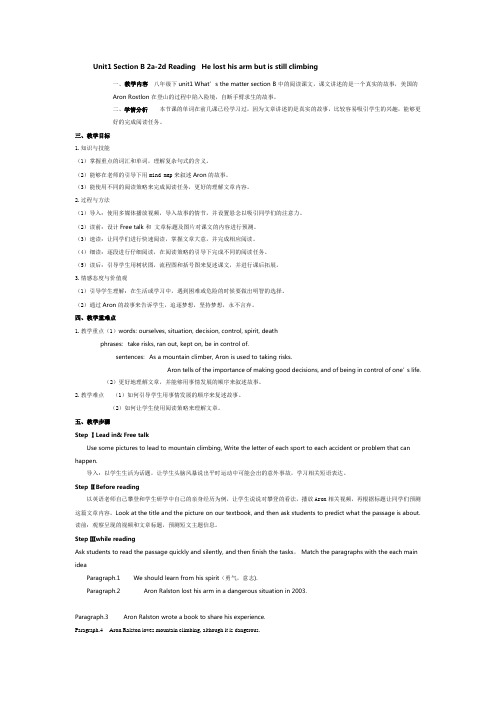
Unit1 Section B 2a-2d Reading He lost his arm but is still climbing一、教学内容八年级下unit1 What’s the matter section B 中的阅读课文,课文讲述的是一个真实的故事,美国的Aron Rostlon 在登山的过程中陷入险境,自断手臂求生的故事。
二、学情分析本节课的单词在前几课已经学习过,因为文章讲述的是真实的故事,比较容易吸引学生的兴趣,能够更好的完成阅读任务。
三、教学目标1.知识与技能(1)掌握重点的词汇和单词,理解复杂句式的含义。
(2)能够在老师的引导下用mind map来叙述Aron的故事。
(3)能使用不同的阅读策略来完成阅读任务,更好的理解文章内容。
2.过程与方法(1)导入:使用多媒体播放视频,导入故事的情节,并设置悬念以吸引同学们的注意力。
(2)读前:设计Free talk 和文章标题及图片对课文的内容进行预测。
(3)速读:让同学们进行快速阅读,掌握文章大意,并完成相应阅读。
(4)细读:逐段进行仔细阅读,在阅读策略的引导下完成不同的阅读任务。
(5)读后:引导学生用树状图,流程图和括号图来复述课文,并进行课后拓展。
3.情感态度与价值观(1)引导学生理解:在生活或学习中,遇到困难或危险的时候要做出明智的选择。
(2)通过Aron的故事来告诉学生,追逐梦想,坚持梦想,永不言弃。
四、教学重难点1.教学重点(1)words: ourselves, situation, decision, control, spirit, deathphrases: take risks, ran out, kept on, be in control of.sentences: As a mountain climber, Aron is used to taking risks.Aron tells of the importance of making good decisions, and of being in control of one’s life.(2)更好地理解文章,并能够用事情发展的顺序来叙述故事。
人教版八年级英语下册《Unit 1》教案

新人教版八年级英语下册《Unit 1》教案一. [话题](Topic)health二.[重点词组](Key Phrases)have a cold患感冒stressed out 紧张的,有压力的bean sprout豆芽get tired感觉疲惫stay healthy保持健康at the moment此刻,现在on the other hand另一方面get a cold患感冒see a dentist看牙医go to the party去参加聚会make sick使某人不舒服(患锁病)have a sore throat嗓子痛have a fever发烧,发热have a toothache牙痛have a backache背痛have a headache头痛三.[交际用语]1 关心别人:你怎么啦?What’s the matter?What’s the matter with you?What’s wrong?What’s wrong with you?2 关心别人:你是不是得……(病)了呀?Do you have a fever?Are you hungry?3 关心别人:你应该……,你最好……,为什么……?You should go to bed early.You shouldn’t eat anything for 24 hours.You’d better go to bed early.You’d better not eat anything for 24 hours.Why not go to bed early?Why don’t you go to bed early?4 关心自己:我不舒服,我病了,我饿了I’m not fe eling well.I have a headache.I am hungry.四. [重点难点释义](Language Points)1.What's the matter, Judy?朱迪,你哪里不舒服?(你怎么了?)matter n.问题,麻烦,事件,通常与介词“with”连用:What's the matter with him?他怎么了?这个句型可以与下面这两个句子互换:What's wrong with him?What's the trouble with him?wrong是形容词,前面没有“the”; matter和trouble都是名词,前面应有“the”, trouble前还可以用形容词性的物主代词。
- 1、下载文档前请自行甄别文档内容的完整性,平台不提供额外的编辑、内容补充、找答案等附加服务。
- 2、"仅部分预览"的文档,不可在线预览部分如存在完整性等问题,可反馈申请退款(可完整预览的文档不适用该条件!)。
- 3、如文档侵犯您的权益,请联系客服反馈,我们会尽快为您处理(人工客服工作时间:9:00-18:30)。
Unit1 What’s the matter?1. KnowledgeWords: have, cold, back, arm, ear, eye, foot, hand, head, leg, mouth, neck, nose, tooth, fever, rest, should, headache, ago, so, illness, thirsty, early, problem, way, traditional, believe, weak, angry, medicine, western, everybody, get, few, stay, important, moment, late, until, yesterday, hearPhrases: have a cold, be stressed out, a few, at the momentStructures: Have for talking about health problems.Modal: should / shouldn’t2. SkillsTalk about your health.Give advice.3. Learning StrategiesUsing what you know.Inferring content.II. BackgroundIII. Teaching Time: Six PeriodsPeriod OneTeaching Aims:1. Learn and master the following words and phrases: matter, have, cold, have a cold, stomachache, sore, back, arm, ear, foot, hand, head, leg, mouth, neck, nose, stomach, tooth, throat2. Develop the students’ listening ability.3. Be able to talk about health.4. Sentence PatternsWhat’s the matter? I have a sore throat.Teaching Difficult PointThe sentence patterns.Teaching MethodsListening practice to train the students’ listening ability.PairwrokTeaching AidsSome pictures.A tape recorder.Teaching ProceduresStep I Greetings.Step II. 1aTeach the students to study the new words by showing some pictures.eye, nose, mouth, ear, tooth, face, head, neck, back, stomach, arm, hand, leg, footAsk a student to read the list of thirteen names of body parts.Then let the students look at the picture and write the correct letter for each part of the body.Check the answers.Answers:k arm c back g ear i eye m foot a hand l head b leg f mouth e tooth d neck j nose h stomach Step III 1bShow some illnesses.e.g. I have a cold. I have a stomachache. Let several students say some illnesses.Ask a student to read the names. Nancy, Sarah, David, Ben, JudyThen play the recording the first time. Students only listen. Play the recording a second time. Students number the names. Cheek the answersAnswers:Nancy = 3 Sarah = 1 David = 2 Ben = 5 Judy = 4Step IV 1cAsk two students to read the conversation.A: What’s the matter?B: I have a sore throat.Then let the students make conversations in pairs.After some minutes, ask several pairs to say their conversations.Explain the language points.1. What’s the matter? 你怎么啦?这句话在口语中很常见,当别人遇到什么麻烦,或身体不舒服,你就可以问What’s the matter?意思是你怎么啦?/ 你遇到什么麻烦啦?/ 你哪儿不舒服?还可以在句末用介词with表示对象。
e.g. —What the matter with you? 你怎么啦?—I can’t find my ticket. 我打不到我的票。
—What’s the matter with your car? 你的车怎么啦?—I can’t start it. 它发动不了了。
2. “have + a +疾病名”表示“患……(病)。
”have a cold (患)感冒have a stomachache 胃痛have a sore back 背痛have a toothache (患) 牙痛have a sore throat (患)咽喉痛have a fever 发烧,发热have a headache (患)头痛have a backache 背痛Step V Summary and HomeworkSummarize what the students have learnt and give them some homework.To make conversations in 1c in pairs.To do some exercises.Period TwoTeaching Aims1. Learn and master the following words: toothache, fever, rest, honey, dentist, should, headache, shouldn’t= shouldnot2. Develop the students’ listening ability.3. Be able to give advice.4. Sentence PatternsWhat’s the matter? I have a toothache.Maybe you should see a dentist. That’s a good idea.He has a stomachache. He shouldn’t eat anything.She has a toothache. She should see a dentist.Teaching Difficult PointThe sentence patterns.Teaching methodsListening practice to train the students’ listening ability.PairworkTeaching AidsA tape recorder.A projector.Teaching Procedures.Step I. Greetings.Step II. RevisionAsk several pairs of students to say their conversations.Do some exercises.写出人体各部分的英语名称。
Step III. 2aTeach the students to study the new words by a projector.toothache n. 牙痛fever n. 发烧;发热rest n. 休息honey n. 蜂蜜dentist n. 牙医should v. 应该headache n. 头痛shouldn’t = should notAsk a student to read the eight items to the class:fever, sore throat, stomachache, toothache, lie down and rest, hot tea with honey, see a dentist, drink lots of waterThen play the recording the first time. Students only listen.Play the recording a second time. Students match the problems with the advice.Check the answers.Step IV 2bAsk the students to look at the pictures. Ask, what can you see in the pictures?Then play the recording again. Ask the students to fill in the blanksCheck the answersStep V 2cAsk two students to read the conversation.A: What’s the matter?B: I have a toothache.A: Maybe you should see a dentist.B: That’s a good idea.Then let the students make conversations in pairs.After some minutes, ask several pairs to say their conver sations.Explain the language point.Maybe you should see a dentist.Step VI Grammar FocusAsk the students to read the sentences.I have a headache. You should go to bed.He has a stomachache. He shouldn’t eat anything.She has a toothache. She should see a dentist.Then let the students make similar sentences.Step VII. Summary and HomeworkSummarize what the students have learnt and give them some homework.To remember the grammar focus.Period ThreeTeaching Aims:1. Learn and master the following words: ago, so, illness, advice2. Sentence PatternsWhat’s the matter? I’m not feeling well. I have a cold.When did it start? About two days ago.Oh, that’s too bad. You should get some rest.Yes, I think so. I hope you feel better soon.3. Review how to talk about health and give advice.Teaching Difficult PointThe sentence patterns.Teaching MethodsPairwork.Groupwork.Teaching AidA projector.Teaching ProceduresStep I. Greetings.Step II. RevisionStep IV 3bAsk the students to read the conversations in 3a in pairs.After some minutes, ask several pairs to say the conversations.Then let the students look at the picture. Ask, what’s the mater with the people in the picture?(He has a toothache. She has a sore back. He has a sore throat. She has a stomachache.)After some minutes, ask several pairs to say their conversations.Step V 4Read the conversation to the class.A: What’s the matter? Do you have a sore throat?B: No, I don’t.C: Do you have a headache?B: Yes, I do.D: You should lie down and rest.Read the instructions and demonstrate what a “mime” is.e.g. Hold your tooth as if you have a toothache. Say, I’m miming a toothache.Ask a student to the classroom of the from and mime an illness. Let the rest of the class guess what the illness is. Give several students an opportunity to come to the front and mime an illness.Step VI Summary and HomeworkSummarize what the students have learnt and give them some homework.To make conversations in 3a in pairs.Period FourTeaching Aims:1. Learn and master the following words:thirsty, early, problem2. Sentence PatternsWhat’s the matter with Gina? She’s tired. She should go to bed early.She shouldn’t go to the party.3. Review how to talk about health and give advice.Teaching Difficult Point.The Sentence Patterns.Teaching Methods.Listening practice to train the students’ listening abilityPairworkTeaching ProceduresStep I Greetings.Step II Revision.Step III 1aAsk the students the four new words and look at the picture.Ask. What are they doing?Let some students answer the questions, then read it.Then let students fill in the blanks.Check the answers.Step IV 1bLet students read the four sentences then read each one again and ask students to repeat the sentences. Listen to the tape. Then let students match each pictureWith one piece of advice. Write the letter of the picture in front of the sentence that gives advice.Correct the answers.Step V 2aLet students look at the chart. Then ask the students listen to the four conversations. Write the problems in the blanks after each person’s name.Correct the answers.AnswersGina: tired Julie: thirstyTony: stressed out Alan: hungryStep VI 2bLet students listen to the four conversations again. Then write what each person should and shouldn’t do for their problems.Answers.Step VII 2cFirst let two students to read the conversation.A: What’s the matter with Gina?B: She’s tired.A: Well, she should go to bed.She shouldn’t go to the party.Let students use the information in Activity 2a to make conversations. Then ask some pairs to perform their conversaions for the class.Step VIII Summary and Homework.Summarize what the students have learnt and give them some homework.To make conversations in 2c in pairs.Period FiveTeaching Aims:Learn and master the following words and phrases way, traditional, believe, weak, angry, medicine, western, everybody, get, few, stay, importantSentence patterns①Traditional Chinese doctors believe we need a balance of yin and yang to be healthy.②Eating Dangshen and Huangqi herbs is also good for this .③It’s easy to have a healthy lifestyle.④People who are too stressed out and angry may have too much yang.Teaching Difficult Point.The sentence patterns.Teaching Methods.Reading practice to train the students’ reading ability. Writing practice to train the students’ writing ability.Teaching AidA projector.Teaching procedures.Step I GreetingStep II New wordsTeach the students to study the new words by a projectorway n. 方法,方式traditional adj. 传统的,惯例的believe v. 相信,认为weak adj. 虚弱的angry adj. 愤怒的,生气的medicine n. 药western adj. 西方的everybody 每人pron get v. 变得few adj. 很少的,几乎没有的stay v. 保持important adj. 重要的Step III 3aRead the article. Then Explain the language points.1. Traditional Chinese doctors believe we need a balance of … Chinese doctors believe that they should eat …在这两个句子中,believe后跟的都是宾语从句,都由that引导,that可以省略。
